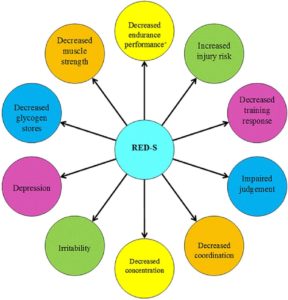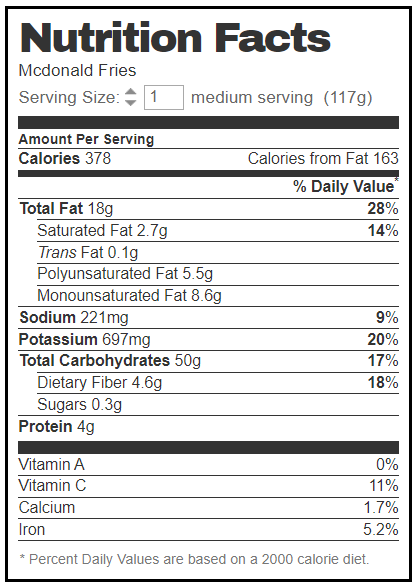
Are You A Female High School Runner? STOP EVERYTHING and Read This:
Being a high school runner is hard. Pressure to get good grades, be accepted by your peers and get into a good college are compounded by pressure to run fast and perform well. Being a female high school runner though, is even harder. Your bodies are changing in a way that may negatively impact your performance and you might start to look different than the women you see on TV or your Instagram feed. Your coach may start to wonder (out loud) why your times are plateauing or even getting slower. At the same time, you may start to feel the pervasive societal pressure telling you that you need to look a certain way. Let’s face it: running is a sport in which lean, fit physiques are idealized. To achieve that physique, many teenage athletes resort to limiting calories or avoiding certain food groups while continuing to train at a high level. The research overwhelming tells us that females in “leanness” sports like running or ballet dancing are at a significantly higher risk of developing a clinical eating disorder than their counterparts in non-leanness sports. Overall, one third of female athletes attending Division 1 schools report attitudes and symptoms that place them at risk for anorexia nervosa (NEDA, 2018).
But…skinny=fast…right? I need to do whatever I can to stay thin, don’t I? The skinnier I am, the faster I will be…right? Maybe at first. Maybe a little. But eventually, you WILL get injured. And after that, you’ll keep getting injured. If calories are being limited or food groups are being avoided in order to lose weight and achieve a certain aesthetic, you will lose in the long run. This chronic limiting of calories or specific food groups can lead to RED-S, relative energy deficiency in sport. RED-S is characterized by a state of chronic low energy availability and can have serious short and long-term health and performance effects. RED-S not only can result in bone density loss and amenorrhea, but also metabolic, cardiovascular and gastrointestinal malfunction. Research has shown that even a deficit as small as 300 calories per day is dangerous. In a practical example, this means that if at the end of the day, you have burned a total of 2200 calories but only consumed 1900 calories, you are setting yourself up for injury. In fact, a recent study conducted at the Canadian Sports Institute Pacific found that athletes suffering from RED-S are a shocking 4.5 times more likely to get a stress fracture than those with adequate nutrition. Can I tell you a secret? Your times are not going to improve if you are sidelined for 12 weeks with a bone injury.

Many elite runners have come forward in recent years to discuss their struggles with RED-S during their high school and college careers. So, if you don’t want to listen to me, take it from the indomitable Lauren Fleshman. Never heard of her? If you’re in high school, she was probably before your time. But suffice it to say that she is one of the greatest middle-distance runners of all time and her essay entitled “Dear Younger Me” still rings true. In my opinion, every high school athlete needs to read it. Actually, every woman should probably read it.
Click Here to read her letter.
+++
NEDA (2018). Eating Disorders and Athletes. Retrieved from: https://www.nationaleatingdisorders.org/eating-disorders-athletes
Keywords: body image, RED-S, fueling, stress fracture, nutrition, runner

Post-Race Recovery…What Should I Eat?
When I was in high school, traveling to away meets was the best. The whole team would pile onto a big yellow bus, drive for an hour, run on a new course against new competitors, then pile back onto the bus and get home after dark. It felt like freedom. No parents, no curfew. Just the rare chance to run in a new place against unknown competitors. The thing that made those meets really exciting though, was that maybe, just maybe, the bus driver would agree to stop at McDonald’s on the way home. When the bus would turn towards those golden arches, a cheer would invariably rise from me and my fellow athletes and we’d excitedly debate what we would order. For me, it was the same thing every time: an M&M McFlurry (soft serve ice cream swirled with chocolate candies) and French fries. Every. Single. Time. I mean, I had just run a race. I deserved to treat myself!
As delicious as my high school post-race meal was, when I look back I realize that none of us were really concerned about consuming the post-race foods that would best enhance our recovery. We simply didn’t know that what we ate after the race was just as important as what we ate before. Considering that only 40% of schools have nutrition education requirements for 9th/10th grade and only 20% have them for 11th/12th grade (IES, 2019), this isn’t too surprising. But that’s a discussion for another day. Back to post-race recovery.
Most experts agree that refueling as quickly as possible post-race is preferable, though research into the supposed 30 min “anabolic window of opportunity” is far from definitive (Aragon, A. A., & Schoenfeld, B. J. (2013). The anabolic window of opportunity argument posits that for maximum recovery and nutrient uptake, fuel must be consumed within 30 minutes after exercise. We runners know though, that eating 30 minutes after a race ends isn’t always feasible. So, for our purposes, I propose that consuming post-race fuel within 2 hours after exertion is preferable and will deliver desired benefits. Click Here to learn more about the post-exercise anabolic window.
So that begs the question…what should I eat? While all research may not agree on when we should eat post-race fuel, most does agree on what we should eat: carbohydrates and protein. Consuming carbohydrates post-race helps us refill our depleted glycogen stores. Refilling these stores ensures that we will have enough energy for the next hard effort. Likewise, protein helps rebuild the muscles we damaged during the race. Research tells us that a 3:1 carbohydrate to protein is ideal for recovery. This means that for every gram of protein we consume, we should consume 3 grams of carbohydrate. Have you heard athletes touting the recovery merits of chocolate milk recently? There’s a reason for that. Chocolate milk contains roughly 30 g of carbohydrates and 8 grams of protein. Pretty darn close to that 3:1 ratio.
Let’s analyze my high school post-race meal to see if it was as good choice.

McFlurry Nutrition Facts
A McFlurry contains 93 grams of carbohydrate and 14 grams of protein for a ratio of almost 7:1. Definitely not enough protein to maximize muscle recovery. But the real issue is that a McFlurry contains a whopping 12 grams of saturated fat and 85 grams of sugar. Those numbers alone make me cringe when I think about how many McFlurries I used to consume!
As for the French fries, they contain 50 grams of carbohydrate and only 4 grams of protein for a ratio of about 12.5:1. Again, too many carbohydrate, not enough protein.

McDonald’s French Fries Nutrition Facts
I think even before analyzing my post-race meal we could all agree that it wasn’t the best choice. I WOULD like to point out that I usually consumed it within 2 hours of competing. So, it wasn’t ALL bad!
Ok ok, so now you know what I shouldn’t eat…what about some ideas of what I CAN eat? Here are some great examples including some packaged options for ease and convenience:
Chocolate Milk
Carbs: 30g
Protein: 8g
Plain Greek Yogurt & Banana
Carbs: 33g
Protein: 17g
Picky Bar (Blueberry Boomdizzle)
Carbs: 24g
Protein: 7g
Rx Bar (Sea Salt Chocolate)
Carbs: 24g
Protein: 12g
I hope this blog post has gotten you thinking about how important your post-race fuel is not only to immediate recovery but also to long-term performance.
What’s your favorite post-race snack? Does it fit into the 3:1 carb:protein ratio?
+++
References:
Aragon, A. A., & Schoenfeld, B. J. (2013). Nutrient timing revisited: is there a post-exercise anabolic window?. Journal of the International Society of Sports Nutrition, 10(1), 5. https://doi.org/10.1186/1550-2783-10-5
IES. (2019). Nutrition Education in Public Elementary and Secondary Schools. National Center for Education Statistics. Retrieved from: https://nces.ed.gov/surveys/frss/publications/96852/
Keywords: recovery, fuel, carbohydrate, protein, race, nutrition
